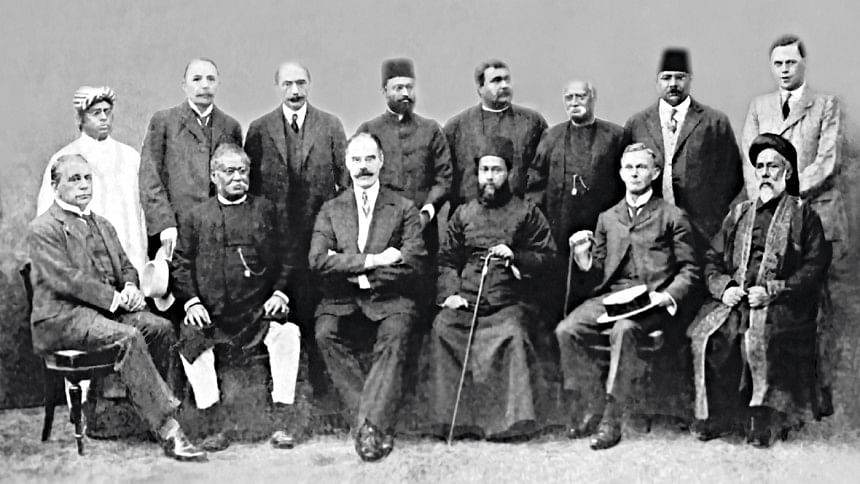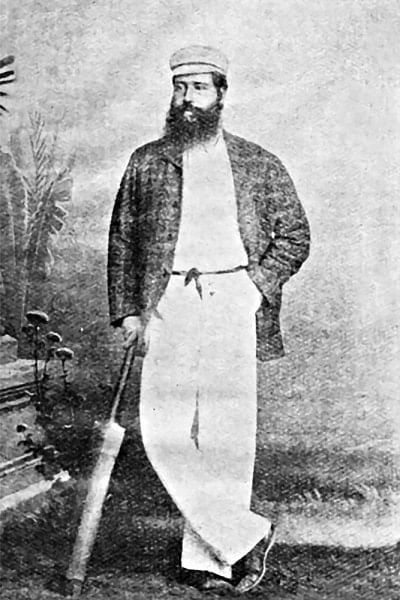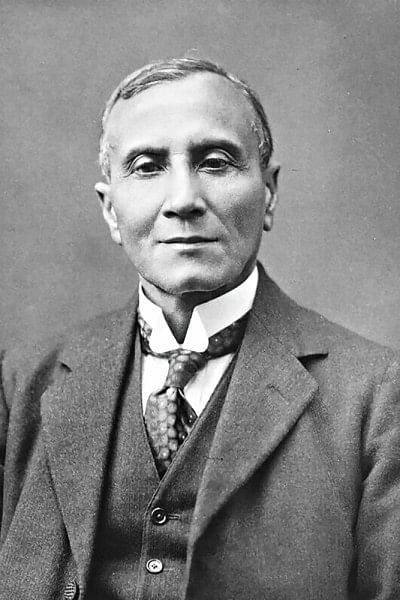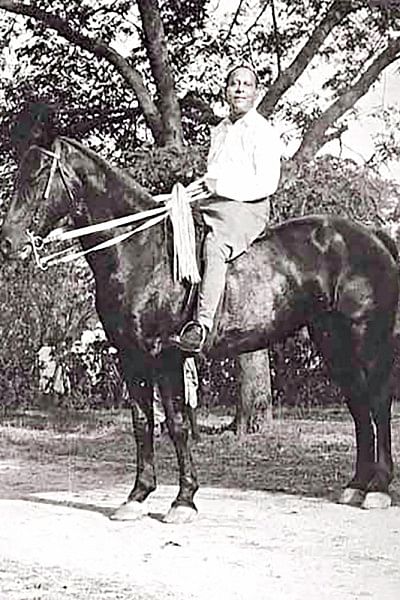Snippets from our history & heritage

In this write-up, I shall briefly touch upon a few eminent personalities of the past who have enriched the lives of generations through their varied contributions to society in the fields of education, arts, sport and culture. I also take this opportunity to add a few paragraph of general interest, including a couple of anecdotes.

Historically, it is a great wonder that three generations of two families - the Rays from Mashua, now in Kishoreganj, and the Jorasanko Tagores, both ardent followers of the progressive Brahmo Samaj and greatly influenced by the ethos of the Bengal Renaissance - completely dominated the socio-cultural scene, particularly in Bengal, from the mid-19th to mid-20th century. Upendrakishore, Sukumar, and Satyajit, originating from Mashua, while the Jorasanko Tagores, comprising of 'Prince' Dwarakanath (the first Indian cultural ambassador to Europe), Maharishi Debendranath (philosopher and socio-religious reformer), and the Nobel Laureate Rabindranath's lineage originated from Jashore, in Bangladesh. These two uniquely multi-talented, creative, and influential families are a marvel of our subcontinent, particularly on both sides of Bengal since the 19th, 20th, and now well into the 21st century. Their phenomenal contributions, particularly in the liberal arts such as Bengali language, literature, art, and culture, remain a mind-boggling legacy, which is hugely inspirational. It has and will continue to define generations yet to come! Here we recall with pride that the cinematic greats of the visual arts, Satyajit Ray, Ritwik Ghatak, and Mrinal Sen, originally hailed from today's Bangladesh.

The famous Rays of Masuha
The ruined zamindar mansion of the illustrious Upendrakishore Ray Chaudhuri (1863-1915), paternal grandfather of Satyajit Ray lies in Mashua, Katiyadi Upazila, in Kishoreganj. Masuha was once a part of the greater Mymensingh region. In the mid-19th century, one Harikishore Ray Chaudhuri had inherited the zamindari of a large estate in Mashua. A childless zamindar, Harikishore, adopted a boy named Kamada Ranjan, son of Kalinath Ray of Mashua and renamed him Upendrokishore Ray, whose multitalented son was none other than Sukumar Ray (1886- 1926), the father of Satyajit Ray. As a highly gifted and imaginative young man, Upendrakishore permanently left Mashua in East Bengal to pursue his luck and dreams in cosmopolitan Kolkata, the vibrant, pulsating capital city of British India. He briefly returned to Mashua when his son Sukumar was born there in 1887. Thereafter, the Ray family became permanent residents of Kolkata. The multifaceted Upendrakishore went on to become a famous writer of juvenile Bangla literature, painter, illustrator, musician, lyricist, composer, violin player, technologist, inventor, amateur astronomer and entrepreneur. Moreover, his younger brother named Saradaranjan Ray, was one of the foremost pioneer of cricket in the subcontinent. He introduced cricket playing amongst the Indians, especially in the Bengal presidency. As the initiator of the game, he was instrumental in establishing the Dacca College Cricket Club in East Bengal (Bangladesh) and at the Town Club in Kolkata. As an avid cricket enthusiast, promoter and practitioner of the game, he is fondly remembered today as a lookalike of the legendary English cricketer W.G.Grace (1848-1915), and for their similar batting style and agility with the willow. Thus, it was a Bengali hailing from Mashua in the then Mymensingh, who introduced the popular game of cricket in British Bengal. I would request the authorities of the Dhaka College, sports historians/reporters and cricket fans here to take note of this historical fact. The pioneering role of Saradaranjan Ray should be highlighted while writing a comprehensive history of cricket in Bangladesh, so that our younger generations can take legitimate pride regarding this forgotten fact of our cricketing history.

Sukumar Ray, son of Upendrakishore, grew up in the enlightened family atmosphere of cosmopolitan Kolkata. His mother, Bidhumukhi Devi, was a daughter of the renowned Dwarkanath Ganguly, a devout member of the Brahmo Samaj who played a progressive role in the advancement of society, particularly in the emancipation of Hindu women in Bengal. Upendrakishore's close friendship and association with the Bengal greats, such as poet Rabindranath Tagore, Jagadish Chandra Bose, Prafulla Chandra Roy, Atul Prasad Sen, et al., profoundly impacted Sukumar's intellectual development and sharpened his finer sensibilities. He graduated with double honors in Physics and Chemistry from Presidency College and trained in photography and printing technology from a reputed institute in London. Thus, he became one of the foremost pioneers of photography and lithography in India. He became a life member of the Royal Photographic Society of London in 1912. His highly acclaimed technical articles were published in notable journals in Britain. In 1913, he set up a successful printing and publishing business in Kolkata and launched a children's magazine called 'Sandesh'. For his unique brand of humor, he is often compared to the genius of Lewis Carol for his fanciful, nonsensical, and gibberish genre of poetry in Bengali literature known in English as limericks ('abol tabol' in Bengali). He created many popular fictitious characters through his prose and poetry, much to the amusement of his readers belonging to all age groups. Sukumar Ray passed away in 1923 in Kolkata, leaving behind a two-year-old infant son named Satyajit Ray, born in 1921, whose phenomenal genius needs no introduction to readers. It is interesting to note that Satyajit Ray's mother, Shuprobha Gupta, was the granddaughter of Dhaka's esteemed social worker, Kali Narayan Gupta. Regrettably, the Kolkata-based Rays, including Satyajit and his sons, Sandeep and Souradeep, lost their emotional ties to their ancestral abode in Mashua, Kishoreganj, in Bangladesh. It is said that they never visited Mashua. Satyajit Ray passed away in Kolkata in 1992.
Muktagacha Raj
One may wonder what happened to the descendants of the once-fabled Muktagacha Raj, known as the zamindars of Mymensingh, following the partition in 1947. The distinguished Snehansu Kanta Acharya Chaudhuri (1913-1986), barrister-at-law, was the son of Maharaja Shashi Kanta Acharya Chaudhuri of Muktagacha, the premier zamindar family of Mymensingh whose family legacy lives on through the worn-out yet imposing Muktagacha Rajbari, the Alexander Castle which had hosted Grand Duke Boris, a cousin of the Czar of Russia, Tagore, Nazrul, Netaji Subhas Bose, to name a few who enjoyed the lavish hospitality of Maharajas Surya Kanta and his son Shashi Kanta. The beautiful Shashi Lodge, popularly known as the Mymensingh rajbari, bears testimony to the opulence and aesthetic taste of the Acharya zamindars.
Snehansu, the son of Shashi Kanta, became the Advocate-General of West Bengal for two terms in independent India. Although born with a silver spoon, he abjured feudalism. In his younger days, he was known as a staunch leftist, closely associated since 1937 with Jyoti Basu, who later became the Chief Minister of West Bengal, India. Snehansu and his wife were both prominent members of the Communist Party of India (Marxist). During the British Raj, he was actively involved in anti-colonial activities, social work, and Marxist politics. The famous exponent and singer of Rabindra Sangeet, Suchitra Mitra, was his sister-in-law. Today, he is remembered in Kolkata for his notable contributions in the fields of law and politics. A law college, 'Snehansu Kanta Acharya Institute of Law' (SKAIL), was established in his name under the University of Kalyani, Kolkata. His son, Sourangshu Kanta Acharya, is a physician while his daughter, Bijoya Goswami, is a Sanskrit scholar in Kolkata.

J.N. Gupta
The distinguished Janendra Nath Gupta (J.N. Gupta), ICS (1892), of the Bengal cadre, was born in 1869 in colonial Bengal. Much of his service career was spent in East Bengal (Bangladesh) in Noakhali, Bogra, Barishal, Rangpur, and Dhaka, where he served as the Commissioner in 1919. He became the Collector and District Magistrate of Rangpur in 1914 for four years. The years he spent there were the happiest in his professional career. In 1916, he founded the renowned Carmichael College in Rangpur, an iconic architectural edifice built in the Indo-Saracenic style. It was also the first premier educational institution of higher learning in the district and in the northern region of the then East Bengal. Both he and his wife extensively toured Rangpur and established girls' schools in remote villages, which the grateful people of the region named after Sarala Devi, J.N. Gupta's wife.
K.G. Gupta
Sir Krishna Govinda Gupta (1851-1926), ICS, bar-at-law, KCSI, was a notable 19th century British Indian civil servant who hailed from the zamindar family of Bhatpara, Narasingdi district, East Bengal. He attended the Pogose and Collegiate Schools in Dhaka and the University College, London. He was called to the Bar from the Middle Temple and was also one the earliest member (the sixth) of the prestigious Indian Civil Service (ICS) qualifying in 1871 and, the first ICS from East Bengal. He was a prominent social reformer and a leading intellectual of the Brahmo Samaj of Dhaka, Mymensingh and Kolkata. His daughters Hem Kushum and Nilini, were married respectively to barrister Atul Prasad Sen the phenomenal lyricist, composer, musician and writer from Bikrampur, East Bengal, and to the noteworthy civil servant Sir Albion Rajkumar Banerjee, ICS, who was born in Bristol, England, in 1871 to social activist Bengali parents hailing from West Bengal. In his lifetime, Sir K.G.Gupta founded the well-known 'Sir K. G. Gupta High School' at Panchdona and the 'Kalinarayan High School' at Kaoraid in 1919, in Narasingdi. He generously donated substantial landed property for the establishment of these schools. There is a lane in his name at Laxmibazar, old Dhaka in his memory.
Jagannath College
One of the oldest and prestigious educational institutions in Dhaka is today's Jagannath University, the establishment of which as a primary school started modestly in 1858, known as the Dhaka Brahma School. The name was later changed to Jagannath School by Babu Kishorilal Roy Chaudhuri the enlightened and philanthropic zamindar of Baliati, Manikganj. He renamed the school in memory of his father Jagannath Roy Chaudhuri. Kishorilal intervened at a critical period in the school's history and generously funded it. In 1884, the school was raised to a college and, the school section was separated to form the Kishore Jubilee School now known as the K.L. Jubilee School. In 2005, Jagannath College was raised to the status of a full-fledged university.
As the old Jagannath College during the Pakistani period, its students were involved in all the progressive political movements of the day from 1948-'71, in concert with the Dhaka University students. The Dhaka University and Jagannath College were the centers of progressive student politics and Bengali/Bangladeshi nationalism. Thus, there developed a symbiotic relationship between the student activists of these two educational institutions. Therefore, on the fateful night of 25th March 1971 during 'Operation Searchlight' both Dhaka University and Jagannath College bore the full wrath of the marauding Pakistani occupation forces, whereby, its teachers, students and staff were specifically targeted, indiscriminately killed and buried in hurried mass graves, while its student dormitories pulverized by artillery shelling and heavy automatic gun fire.
Establishment of Dhaka University
The annulment of the Partition of Bengal (1905) in December 1911, at the Delhi Coronation Durbar by King Emperor George V, led to the demand for the establishment of a university in Dhaka by the Muslim elite at the behest of Nawab Salimullah, which was actively supported by Nawab Syed Nawab Ali Chowdhury and others. As compensation for the annulment, the British Raj conceded the petition for Dhaka University during the visit of the Viceroy and Governor-General of British India, Lord Hardinge, to Dhaka in 1912. This led to the formation of the Dhaka University Committee in 1912, also known as the Nathan Commission, comprising notable personages of the day. Finally, Dhaka University came into being in 1921. However, it is surprising to note that while declaring Dhaka as the capital city of Eastern Bengal and Assam in 1905, the British Raj did not envisage building either a hospital for public welfare or a university in the new provincial capital. They were too preoccupied with the idea of ensuring Pax Britannica by expeditiously erecting grandiose mansions, administrative buildings, attractive red bungalows for incoming Raj officials, and even an English cottage-type Chummery House for accommodating British bachelors of the civil and military bureaucracy in the greater Ramna area of 'new Dhaka'.
However, the fortuitous founding of the Dhaka University in 1921, slowly but surely resulted in the steady growth of a burgeoning educated middle class (bourgeoisie) in East Bengal, who became politically conscious in the decades to follow leading up to the partition of British India in 1947. The sad exodus of the Bengali Hindu professionals, intelligentsia and cultural personalities from East Bengal to West Bengal, resulted in a temporary void in many spheres of the society in East Bengal, which was somewhat compensated by incoming Bengali Muslim professionals and intellectuals from West Bengal, many of whom belonged to the educated professional elite with a higher socio-economic status. This reverse migration also included a sizeable Bengali Muslim community who originally belonged to East Bengal, but had relocated over the years to West Bengal (read Kolkata) during the Raj, for want of better opportunities. Therefore, coming as many did from the cosmopolitan atmosphere of Kolkata they were thus politically more exposed, experienced and conscious, thereby, ready to play a significant socio-political role along with their brethren in East Bengal/Pakistan in the difficult days ahead. Ultimately, on 16 December 1971, together with the freedom loving people of the country and, through exemplary feats of sacrifice in a nine-month long liberation war a new nation, Bangladesh, was born.
Waqar A Khan is the Founder of Bangladesh Forum for Heritage Studies

 For all latest news, follow The Daily Star's Google News channel.
For all latest news, follow The Daily Star's Google News channel. 



Comments